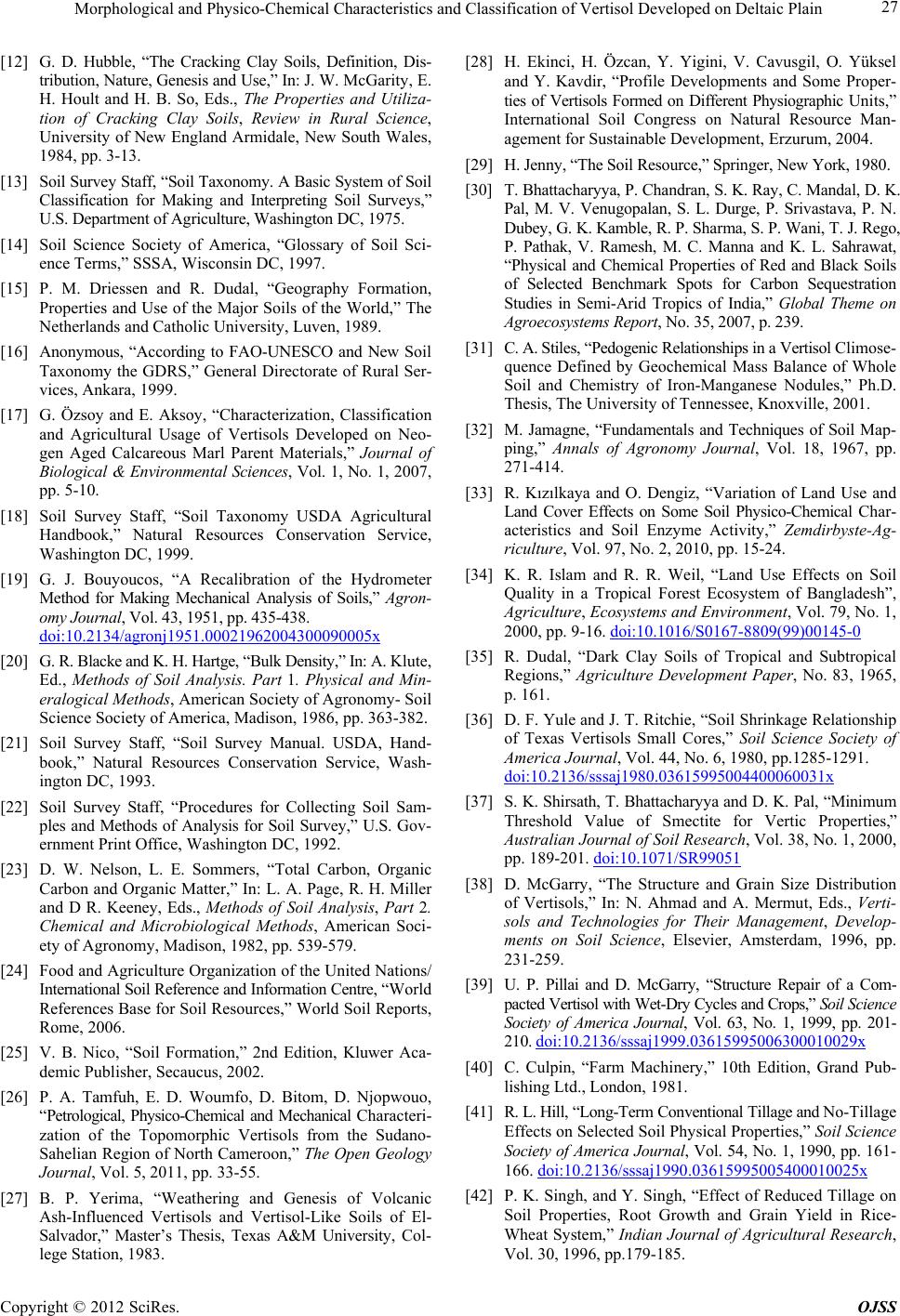
Morphological and Physico-Chemical Characteristics and Classification of Vertisol Developed on Deltaic Plain
Copyright © 2012 SciRes. OJSS
27
[12] G. D. Hubble, “The Cracking Clay Soils, Definition, Dis-
tribution, Nature, Genesis an d Use, ” In: J. W. M c G a r i ty, E .
H. Hoult and H. B. So, Eds., The Properties and Utiliza-
tion of Cracking Clay Soils, Review in Rural Science,
University of New England Armidale, New South Wales,
1984, pp. 3-13.
[13] Soil Survey Staff, “Soil Taxonomy. A Basic System of Soil
Classification for Making and Interpreting Soil Surveys,”
U.S. Department of Agriculture, Washington DC, 1975.
[14] Soil Science Society of America, “Glossary of Soil Sci-
ence Terms,” SSSA, Wisconsin DC, 1997.
[15] P. M. Driessen and R. Dudal, “Geography Formation,
Properties and Use of the Major Soils of the World,” The
Netherlands and Catholic University, Luven, 1989.
[16] Anonymous, “According to FAO-UNESCO and New Soil
Taxonomy the GDRS,” General Directorate of Rural Ser-
vices, Ankara, 1999.
[17] G. Özsoy and E. Aksoy, “Characterization, Classification
and Agricultural Usage of Vertisols Developed on Neo-
gen Aged Calcareous Marl Parent Materials,” Journal of
Biological & Environmental Sciences, Vol. 1, No. 1, 2007,
pp. 5-10.
[18] Soil Survey Staff, “Soil Taxonomy USDA Agricultural
Handbook,” Natural Resources Conservation Service,
Washington DC, 1999.
[19] G. J. Bouyoucos, “A Recalibration of the Hydrometer
Method for Making Mechanical Analysis of Soils,” Agron-
omy Journal, Vol. 43, 1951, pp. 435-438.
doi:10.2134/agronj1951.00021962004300090005x
[20] G. R. Blacke and K. H. Hartge, “Bulk Density,” In: A. Klute,
Ed., Methods of Soil Analysis. Part 1. Physical and Min-
eralogical Methods, American Society of Agronomy- Soil
Science Society of America, Madison, 1986, pp. 363-382.
[21] Soil Survey Staff, “Soil Survey Manual. USDA, Hand-
book,” Natural Resources Conservation Service, Wash-
ington DC, 1993.
[22] Soil Survey Staff, “Procedures for Collecting Soil Sam-
ples and Methods of Analysis for Soil Survey,” U.S. Gov-
ernment Print Office, Washington DC, 1992.
[23] D. W. Nelson, L. E. Sommers, “Total Carbon, Organic
Carbon and Organic Matter,” In: L. A. Page, R. H. Miller
and D R. Keeney, Eds., Methods of Soil Analysis, Part 2.
Chemical and Microbiological Methods, American Soci-
ety of Agronomy, Madison, 1982, pp. 539-579.
[24] Food and Agriculture Organization of the United Nations/
International Soil Reference and Information Centre, “W o r ld
References Base for Soil Resources,” World Soil Reports,
Rome, 2006.
[25] V. B. Nico, “Soil Formation,” 2nd Edition, Kluwer Aca-
demic Publisher, Secaucus, 2002.
[26] P. A. Tamfuh, E. D. Woumfo, D. Bitom, D. Njopwouo,
“Petrological, Physico-Chemical and Mechanical Characteri-
zation of the Topomorphic Vertisols from the Sudano-
Sahelian Region of North Cameroon,” The Open Geology
Journal, Vol. 5, 2011, pp. 33-55.
[27] B. P. Yerima, “Weathering and Genesis of Volcanic
Ash-Influenced Vertisols and Vertisol-Like Soils of El-
Salvador,” Master’s Thesis, Texas A&M University, Col-
lege Station, 1983.
[28] H. Ekinci, H. Özcan, Y. Yigini, V. Cavusgil, O. Yüksel
and Y. Kavdir, “Profile Developments and Some Proper-
ties of Vertisols Formed on Different Physiographic Units,”
International Soil Congress on Natural Resource Man-
agement for Sustainable Development, Erzurum, 2004.
[29] H. Jenny, “The Soil Resource,” Springer, New York, 1980.
[30] T. Bhattacharyya, P. Chandran, S. K. Ray, C. Mandal, D. K.
Pal, M. V. Venugopalan, S. L. Durge, P. Srivastava, P. N.
Dubey, G. K. Kamble, R. P. Sharma, S. P. Wani, T. J. Rego,
P. Pathak, V. Ramesh, M. C. Manna and K. L. Sahrawat,
“Physical and Chemical Properties of Red and Black Soils
of Selected Benchmark Spots for Carbon Sequestration
Studies in Semi-Arid Tropics of India,” Global Theme on
Agroecosystems Report, No. 35, 2007, p. 239.
[31] C. A. Stiles, “Pedogenic Relationship s in a Vertisol Climose-
quence Defined by Geochemical Mass Balance of Whole
Soil and Chemistry of Iron-Manganese Nodules,” Ph.D.
Thesis, The University of Tennessee, Knoxville, 2001.
[32] M. Jamagne, “Fundamentals and Techniques of Soil Map-
ping,” Annals of Agronomy Journal, Vol. 18, 1967, pp.
271-414.
[33] R. Kızılkaya and O. Dengiz, “Variation of Land Use and
Land Cover Effects on Some Soil Physico-Chemical Char-
acteristics and Soil Enzyme Activity,” Zemdirbyste-Ag-
riculture, Vol. 97, No. 2, 2010, pp. 15-24.
[34] K. R. Islam and R. R. Weil, “Land Use Effects on Soil
Quality in a Tropical Forest Ecosystem of Bangladesh”,
Agriculture, Ecosystems and Environment, Vol. 79, No. 1,
2000, pp. 9-16. doi:10.1016/S0167-8809(99)00145-0
[35] R. Dudal, “Dark Clay Soils of Tropical and Subtropical
Regions,” Agriculture Development Paper, No. 83, 1965,
p. 161.
[36] D. F. Yule and J. T. Ritchie, “Soil Shrinkage Relationship
of Texas Vertisols Small Cores,” Soil Science Society of
America Journal, Vol. 44, No. 6, 1980, pp.1285-1291.
doi:10.2136/sssaj1980.03615995004400060031x
[37] S. K. Shirsath, T. Bhattacharyya and D. K. Pal, “Minimum
Threshold Value of Smectite for Vertic Properties,”
Australian Journal of Soil Research, Vol. 38, No. 1, 2000,
pp. 189-201. doi:10.1071/SR99051
[38] D. McGarry, “The Structure and Grain Size Distribution
of Vertisols,” In: N. Ahmad and A. Mermut, Eds., Verti-
sols and Technologies for Their Management, Develop-
ments on Soil Science, Elsevier, Amsterdam, 1996, pp.
231-259.
[39] U. P. Pillai and D. McGarry, “Structure Repair of a Com-
pacted Vertisol with Wet-Dry Cycles and Crops,” Soil Scie n ce
Society of America Journal, Vol. 63, No. 1, 1999, pp. 201-
210. doi:10.2136/sssaj1999.03615995006300010029x
[40] C. Culpin, “Farm Machinery,” 10th Edition, Grand Pub-
lishing Ltd., London, 1981.
[41] R. L. Hill, “Long-Term Conventional Tillage and No- Tillag e
Effects on Selected Soil Phy sical Properties,” Soil Science
Society of America Journal, Vol. 54, No. 1, 1990, pp. 161-
166. doi:10.2136/sssaj1990.03615995005400010025x
[42] P. K. Singh, and Y. Singh, “Effect of Reduced Tillage on
Soil Properties, Root Growth and Grain Yield in Rice-
Wheat System,” Indian Journal of Agricultural Research,
Vol. 30, 1996, pp.179-185.